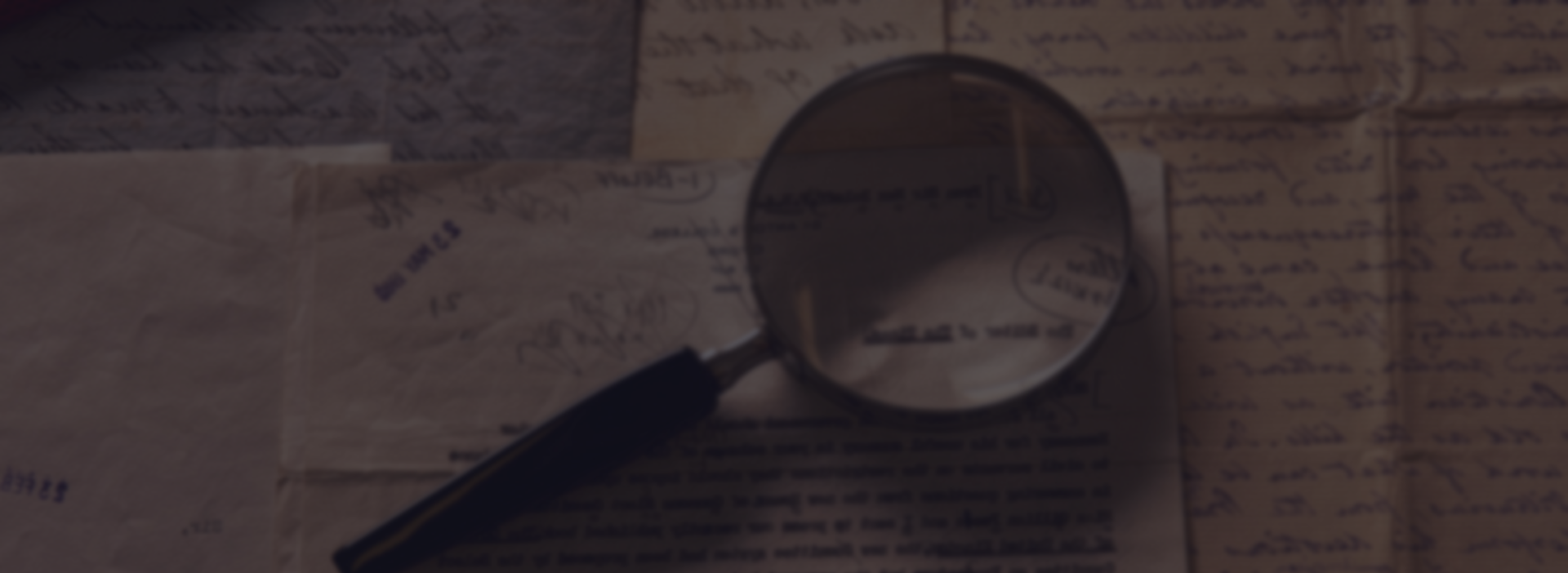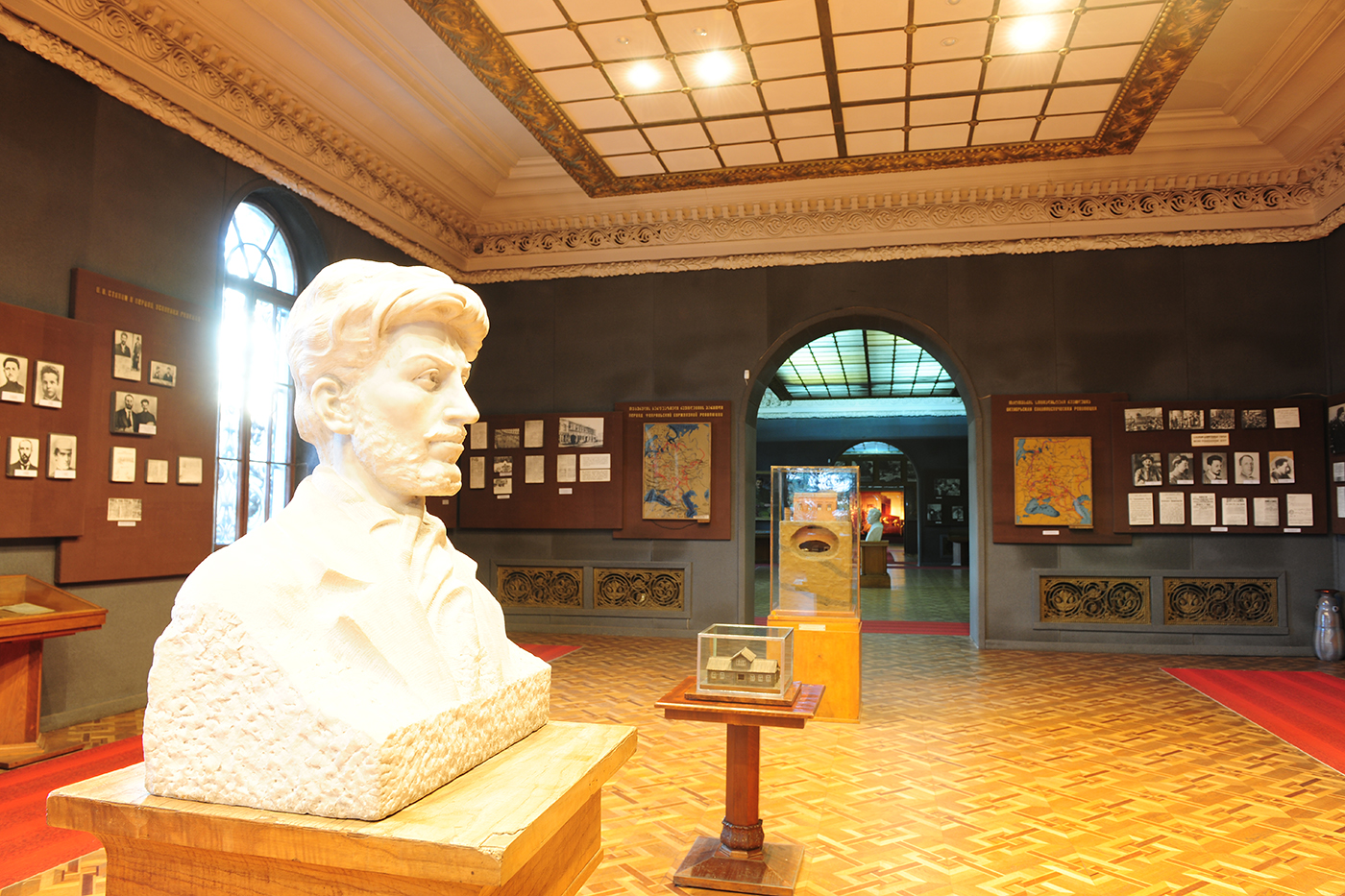

08 November 2021
Author: Anton Vatcharadze
The Myth about Stalin and the De-Realization of Past
“Children under 6 are not allowed. Price for school students - 1 GEL” – says the official website of Stalin’s birth-house museum in Gori. Historical Stalin in contemporary Georgia – nostalgic requisite of political mythology or the creator tyrants of bloody terror? – We will attempt to respond to this question in this article. First of all, we should mention that established notions about Stalin are different from the heroic stories about him. This is the result of mass propaganda and bureaucratic procedures based not on the truth but the repeated acts related to rituals and state ceremonials. The mythology about a Great Georgian Leader in Georgia enhances not only specific facts and argument but rhetorical contexts and utilizes such notions in the society as “father of the nations”, “wise leader”, “paranoiac person” and “sadist”, “triumphant of WWII”, “creator of modernization and social counter-modernization”, “main subject of attack by internal and external enemies”, “apologetic of inevitable mass terror”. In the part of Georgian society, it is still widely believed that fighting against Fascism and enhancing social mobilization and modernization was only possible as a result of mass terror.
Mass Trauma in Georgia
In social surveys, frequently, the same people assess Stalin both positively and negatively (Carnegieeurope 2013). Such ambivalence is a characteristic of a post-totalitarian, traumatized society. In the Soviet Georgian thinking, it has become widely believed that everything valuable requires bloody sacrifice. Such cultural norms indicate the weak potential of social solidarity and still prevalent trauma related to the totalitarian past. Children of the repressed were often subject to double identification – victim and aggressor, causing the depersonalization of their self-identification. This is proved by the fact that they similarly grieved their parent and Stalin. The Soviet system replaced the “disappeared” parents with the image of a solicitous Stalin. On the other hand, the vulnerability and fear of society placed it in the victim category as well. Also, their negligence of mass repressions caused their self-identification with the aggressor. This cognitive dissonance turned the society subordinate to the regime. Consequently, ordinary people acquired the role of a victim and an aggressor simultaneously: their service to the regime did not save them from repressions. They were forced to support the repressions against others, otherwise, they would become victims themselves. This totalitarian trauma affected the sense of security in the Georgian society, its dignity, control over its life and personal and emotional values.
To overcome this trauma, it is necessary to mourn it. Mourning may encompass different aspects of social life - for instance, the erection of monuments, rethinking of the past, restoration of justice through various social and political mechanisms In Soviet Georgia, such mourning was impossible, it opposed the self-defence instinct. After the declaration of independence, trauma has been expelled but it has not been mourned. The traumatic events in the post-Soviet period turned the social reaction into pseudo-mourning.
The Georgian society simultaneously condemns the Soviet past and feels nostalgic about it. According to the social surveys conducted in the 2010s, 25% of the Georgian society feels respect toward Stalin while 15% says they would be happy if a leader like him run the country (Carnegieeurope 2013). These positive sentiments toward Stalin can be explained by nationalist pride. He is the only Georgian man who ruled half the world.

State and Legal Attempts of Rethinking the Totalitarian Past
The Government of Georgia under President Mikheil Saakashvili signed the Freedom Charter in 2011 by which it finally expressed its attitude toward the Soviet past (Cevro, n.d.). The reason for this was that the former KGB building burned during the civil war and 210,000 archival materials (80% of all materials) were destroyed. Moreover, many of the materials of the Security Council were taken to Moscow (Cevro, n.d.). For lustration, such materials are of paramount importance (IDFI 2016). One of the purposes of the law is the removal of the symbols and names of cult buildings, memorials, monuments, bas-reliefs, inscriptions, streets, squares, villages and settlements of the communist totalitarian regime, as well as the prohibition of the propaganda instruments and other means of communist totalitarian and national socialist (Nazi) ideologies. For this, the law foresees the creation of a special commission at the State Security Service. The Commission collects data and keeps a database of persons, who have secretly collaborated with the intelligence services of the former USSR or who might be the subject of secret cooperation with the intelligence services of the former USSR as provided for by the legislation of Georgia. In the case of addressing the competent person by the Commission, the competent person shall eliminate communist totalitarian and/or national socialist (Nazi) symbols. Otherwise, the competent person is given a warning and in the case of a repeated breach of the law, he/she is fined 1000 GEL. In 2015, IDFI requested the information based on which, it became known that until 2015, the Commission had only held one meeting. In 2016-2017, the Commission addressed only 5 entities to stop displaying communist totalitarian symbols. But in 2017-2019, the number of addresses has increased.
In 2013, a demonstration “50 Statues of Stalin that Should be Painted” was held. His statues were pained in Telavi, Akura, Alvani, Kvareli, Ateni, Chokhatauri, which was followed by the negative reaction from the individuals with positive sentiments toward Stalin’s figure. On the other hand, several statues were erected at different locations. For instance, the last case was monitored in the village Zikilia in February 2020, when the locals erected the iron construction of Stalin’s image. The representative of the Mayor in the village said that it was the locals’ will and he could not oppose them. In this regard, the issue of Stalin’s statue in Gori, which is currently kept in Berbuki, near the agency established by the City Hall of Gori, is most popular. In 2010, the Government of Georgia removed Stalin’s statue from the centre of Gori without warning either media or society (IDFI 2020/11). Former Minister of Culture, Nikoloz Rurua said: “I believe Stalin was a political criminal, who led the Russian Bolshevik army into Georgia in 1921, which eventually carried out Georgia's occupation. […] It is negligence to simultaneously have a memorial dedicated to heroes fighting for Georgia’s independence and Stalin’s statue in the country” (BBC 2010).
After the restoration of independence in 1991, Stalin’s and Lenin’s statues were removed in Georgia but his statue in Gori was maintained even after the 2008 Russo-Georgian war. Traditionally, on every 21 December, Stalin’s birthday, Georgian Stalinsts gather in the garden of Stalin’s birth-house museum and protest the removal of Stalin’s statue from the city centre.

In 2013, the local government even allocated funds from the budget for the restoration of the monument on the territory of the museum, but following the request of the Ambassadors of the Baltic states, the process was interrupted. In 2015, the organization Gorelebi addressed the Gori City Hall with the request to re-erect the monument and the Assembly of Gori also discussed the issue but voted against the re-erection of the statue. However, public discussion regarding Stalin’s statue are still active in Georgia. Also, it is notable that until now, there are the streets named after Stalin in Georgia (IDFI 2020/11).
The Museum
In today’s Georgia, the societal attitude towards Stalin’s memory, monuments, house-museum, represent a productive prism through which the attitude towards Stalin – as a political, historic, moral personality can be studied, taking in mind controversial, ambivalent assessments. It is exactly from this perspective that we would like to touch upon Stalin’s museum in Gori. The State Museum Complex situated on Stalin Avenue encompasses memorial residence (where Stalin was born), Stalin’s train coach and two-storied exposition hall. The museum collects unique exhibits: (over 40.000 exhibits, documents, applied art canvasses and auxiliary museum materials) memorial objects, gifts, painted canvasses, photo-cinematic documents.

The epoch-depicting artifacts and stationary exposition reflecting Stalin’s life and deeds are spread across six halls. The majority of the visitors view the museum while hearing comments from the museum guide. From that narrative you can learn about the educational projects and massive opening of schools during the Soviet times, economic successes and the accomplishments of industrialization. However, viewing the small room holding the materials on Soviet repressions, which has been active since 2010, takes not more than several minutes; and that only in case you encounter an open door. After the 2008 war, the visitors more and more often have been voicing the view that the Museum responds to the Soviet realities and namely, repressions with a deaf silence (Gotfredsen 2013). The “request” of the visitors has been met and the exhibition is enriched with the artifacts “depicting reality”, however the room out of the visible area does not even have a signage, so as the arriving visitor or tourist wouldn’t miss it. The copies of the triangular letters sent from the Gulags occupy one side of the room wall. There are about 20 letters pinned to the wall, on which the names of the exiled are written, while on the other side of the room the information taken from the Soviet journals is exhibited. As we learn from one of the excerpts, the blame for sending people in the exile and shooting them is not upon Stalin, but rather upon the non-court voluntary entities - so called “Troikas” and “Dvoikas”. On the far away walls the photo-material depicting the events of 2008 can be encountered. The Museum is the most significant if not the only sight of the city of Gori and it attracts about 50.000 foreign tourists every year.

The Museum Complex opened in 1957 after the death of Stalin. However, memorial museum had existed in the house where Stalin was born since 1937, while Stalin was alive. It is worth the attention that the founding of Stalin’s Museum happened in the same controversial times like Georgia is going through now. The 1957 “Secret Speech” by Khrushev gave rise to mass turbulence and spontaneous protest that was soaked with the Stalinist-nationalist ideas for the purpose of protecting the good name of “the Great Son of the Georgian Nation” and to which hundreds of people lay victim infamously. From the perspective of historian Lasha Bakradze, the Complex is in need of reorganization and it is important that the space for conveying human stories and tragedies of real Soviet people is added right in the main hall, which will give a kind of critical assessment to the essence of the Museum itself: “This Museum is the example of the attitudes people in our country have towards history. Generally, we are in an absolutely obscure relationship with history and we are unable to rethink it. And that tiny “room of repressions, which is today located under the stairs, is just pulling the wool over the eyes”, - Lasha Bakradze (Radiotavisupleba 2019). If we listen to Karp and Levin the original exhibition was created so as: “to solidify one truth and reject the other”. Stalin’s Museum in Gori is a state institution at the crossroad of rethinking historical facts and modern political changes, but despite the efforts and wishes of the government to present critical attitudes towards totalitarian communist times, the delivery of homogenous messages to the visitors runs into an obstacle, in a way the reason for that is structural ambivalence of the exhibition itself and the attitudes and sentiments of the Museum personnel on the other hand. We can regard the showing of a certain/specific version of the Soviet history and a certain emphasis on the Chief’s nationality as the purpose of original exhibition, however in the context of current political circumstances underlining of the role Stalin played in the making of Communism has lost actuality. The Museum is mostly an effort to read the Soviet history; the history that is rejected and expelled today and runs against the Georgian national statehood. “Stalin’s Museum is a peculiar thing and the fact that it survived – astonishing. We must make it safe. Everyone should see how primitive the Soviet propaganda was. How primitive the cult of Stalin was. Hence, we should preserve it.”- explains Lasha Bakradze. In the future, according to his view, the unused spaces in the museum must be transformed into “parallel exhibitions” that will “clarify” the main exhibition (Radiotavisupleba 2019).
The Repressed – Georgian Reality
After the collapse of communist regimes, the states in Eastern Europe and the Post-Soviet space that chose the path of democratization, have taken the obligation to restore the citizens’ infringed rights and their legal rehabilitation. It is stemming from exactly the positive obligation vested on the state, that Georgia has the obligation to restore the rights violated as a result of political repressions undertaken on the territories of the former Soviet Union and the obligation to carry out relevant effective measures for that very purpose. It is worth mentioning that the respect for democratic values, including human rights and fundamental freedoms represents one of the cornerstone principles of the Association Agreement between Georgian and the European Union. Our Institute – IDFI, together with the society of the memory of and support for the victims of the Soviet-era repressions -“Memorial”, actively requests the increase of the social and living subsidy (7 GEL) allocated to the repressed persons and requests that it becomes equal to the amount of living subsidy (44 GEL) (IDFI 2020/4). From 2012 onwards, dozens of letters have been sent to various entities. On each of those letters, the organizations would receive a standard rejection that “those funds are not envisaged in the Budget” or “that would entail legitimate dissatisfaction among the persons in other categories having the request to have the same benefit” (IDFI 2020/12). All of these, unfortunately, prove the dismal reality that:
· Those around 10.000 repressed persons who have undergone great humiliation, abuse and harassment during the Soviet era do not represent a priority for the State and they are allocated the lowest of the subsidies.
· The Georgian State does not take efforts in that direction to share the European practices, where the compensation and social assistance of the repressed is undertaken with high standards and where those persons not only receive compensation, but return their deprived property as well.

In conclusion we can say that working on coping with the totalitarian past expelled from the societal consciousness shall start with raising the awareness level. It is important that the society rethinks the traumatic experience in a multidisciplinary format, as the problem of repressions is a complex one and is in need of the study and reaction in the similar format, for which primarily the State should create relevant legal environment. What is most worthy of attention is that the awareness of the young generation on totalitarian past should be raised; their involvement in the memorization of the victims of the repression and the symbolization of the repression-related trauma should be supported; when it comes to the personality of Stalin himself, as if it was said to V.M.Molotov and A.E. Golovanov in 1943 by the Chief himself:
“Mistakes were abounding, but we had successes as well, right? The mistakes will be ascribed to me, it’s natural. My grave will be thrown garbage at, but the time will come when the wind of history will sweep away that garbage.” (Topwar 2019). In today's reality, the amount of garbage is increasing in parallel with the opening of secret archives and with the disclosure of previously unavailable information. This is the main reason why in the modern Russian Federation, whose leader somehow reflects Stalin's personality and, according to many scholars, identifies with him, tries in every way to prevent the opening of archives.
But still, the wind of history is inerrable, the study of and dualistic attitude towards the personality and cult of Stalin will not lose actuality in the future and is likely to remain the subject of constant controversies for the generations to come… Until social dualism is overcome and one position is not formed, there is a need for discussion and re-analysis, which hopefully future generations will be able to cope with success and based on general humanistic ideas and ideals.
__________________________________
Sources:
1. Carnegieeurope. Thomas de Waal, Maria Lipman, Lev Gudkov, Lasha Bakradze. “The Stalin Puzzle: Deciphering Post-Soviet Public Opinion”. Published March 1, 2013.
https://carnegieeurope.eu/2013/03/01/stalin-puzzle-deciphering-post-soviet-public-opinion-pub-51075 Accessed June 28, 2021.
2. Cevro Institute. Giorgi Kldiashvili, “Lustration”/ Anton Vatcharadze, “Regime Archives”. Memory of Nations: Democratic Transition Guide, Georgian Experience.
http://www.cevro.cz/web_files/soubory/democracy-guide/democracy-guide-2019/MN-DTG%202019%20-%20(07)%20The%20Georgian%20Experience.pdf Accessed June 28, 2021.
3. Institute for Development of Freedom of Information (IDFI). “Failed Lustration Process in Georgia”. Published 25 January 2016.
https://idfi.ge/en/failed-lustration-in-georgia Accessed June 28, 2021.
4. Institute for Development of Freedom of Information (IDFI). “The Overview of the Memory Politics of Georgia”. Published 10 November 2020.
https://idfi.ge/en/the_overview_of_the_memory_politics_of_georgia Accessed June 28, 2021.
5. BBC. “Stalin statue taken down in his Georgian hometown”. Published 25 June 2010.
https://www.bbc.com/news/10412097
6. Gotfredsen, Katrine. 2013. “Evasive Politics: Paradoxes of History, Nation and Everyday Communication in the Republic of Georgia.” PhD dissertation. University of Copenhagen. Accessed June 28, 2021.
7. რადიო თავისუფლება (Radiotavisupleba/ Radio Free). “ამით გავიხსენებ საქართველოს" - იცით, რას ჰყვება სტალინზე გორის მუზეუმი?” ("I will remember Georgia with this" - do you know what the Gori Museum says about Stalin?”). Published November 1, 2019. https://bit.ly/2Sx1AyN Accessed June 28, 2021.
8. Institute for Development of Freedom of Information (IDFI). „The Statistics of Social Assistance for the Victims of Political Repressions“. Published 28 April 2020.
https://idfi.ge/en/statistics_of_social_assistance_to_victims_of_political_repression Accessed June 28, 2021.
9. Institute for Development of Freedom of Information (IDFI). “IDFI Calls for the Prime Minister of Georgia to Increase the Subsidy for the Repressed Individuals in the 2021 State Budget”. Published 15 December 2020.
https://idfi.ge/en/idfi_calls_for_the_prime_minister_of_georgia Accessed June 28, 2021.
10. Topwar. "После моей смерти на мою могилу нанесут кучу мусора, но ветер истории безжалостно развеет её" (“My grave will be thrown garbage at, but the time will come when the wind of history will sweep away that garbage.”). Published 30 October 2019.
https://topwar.ru/164105-posle-moej-smerti-na-moju-mogilu-nanesut-kuchu-musora-no-veter-istorii-bezzhalostno-razveet-ee.html Accessed June 28, 2021.